How to load data from MySQL to PostgreSQL?: 2 Easy Ways


MySQL is an SQL (Structured Query Language)-based open-source database management system. An application with many uses, it offers a variety of products, from free MySQL downloads of the most recent iteration to support packages with full service support at the enterprise level. The MySQL server, while most often used as a web database, also supports e-commerce and data warehousing applications and more.
An object-relational database management system, PostgreSQL is able to handle a wide range of workloads, supports multiple standards, and is cross-platform, running on numerous operating systems including Microsoft Windows, Solaris, Linux, and FreeBSD. It is highly extensible, and supports more than 12 procedural languages, Spatial data support, Gin and GIST Indexes, and more. Many web, mobile, and analytics applications use PostgreSQL as the primary data warehouse or data store.
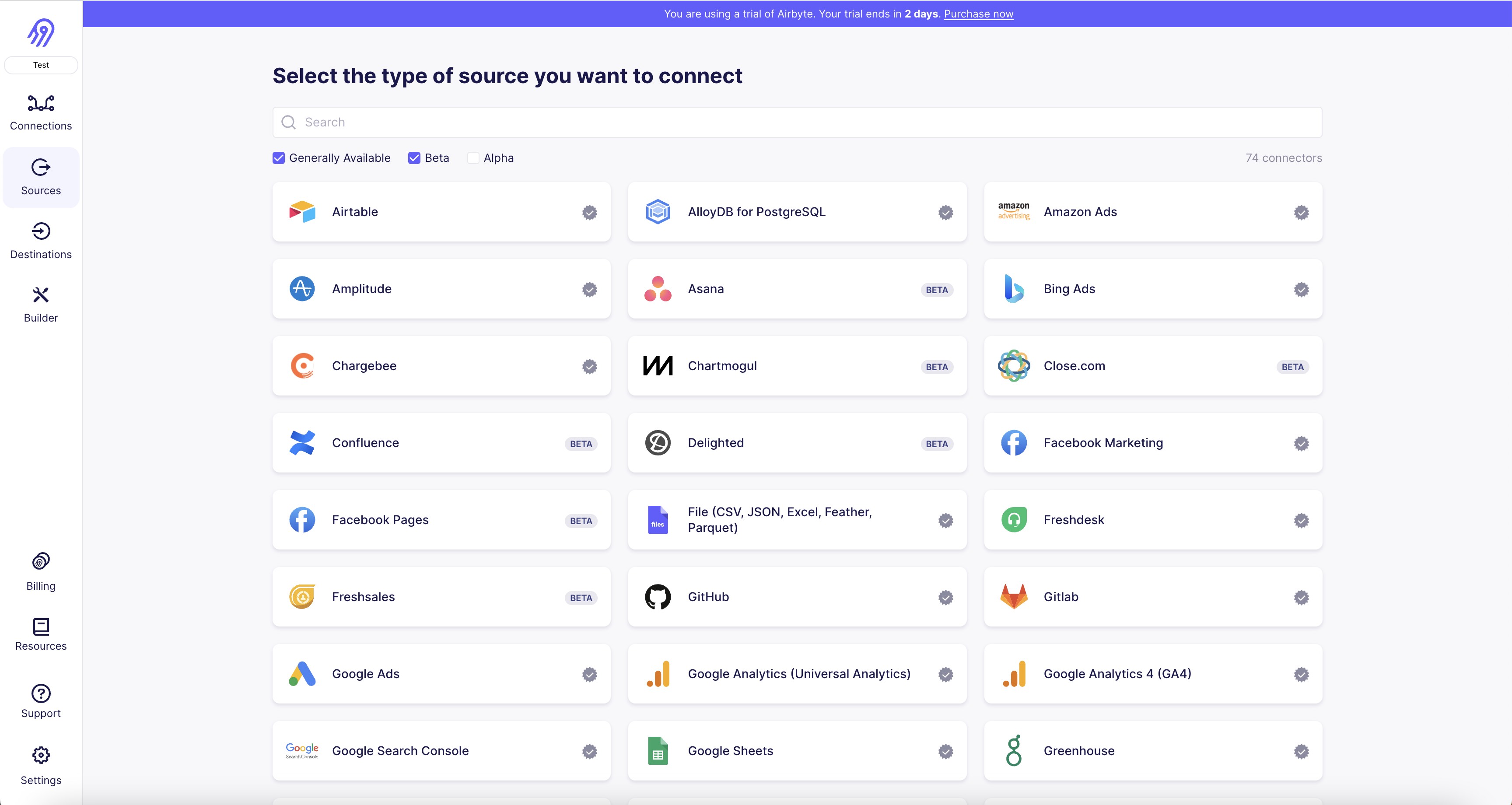
1. Open the Airbyte UI and navigate to the "Sources" tab.
2. Click on the "Add Source" button and select "MySQL" from the list of available sources.
3. Enter a name for your MySQL source and click on the "Next" button.
4. Enter the necessary credentials for your MySQL database, including the host, port, username, and password.
5. Select the database you want to connect to from the drop-down menu.
6. Choose the tables you want to replicate data from by selecting them from the list.
7. Click on the "Test" button to ensure that the connection is successful.
8. If the test is successful, click on the "Create" button to save your MySQL source configuration.
9. You can now use your MySQL connector to replicate data from your MySQL database to your destination of choice.

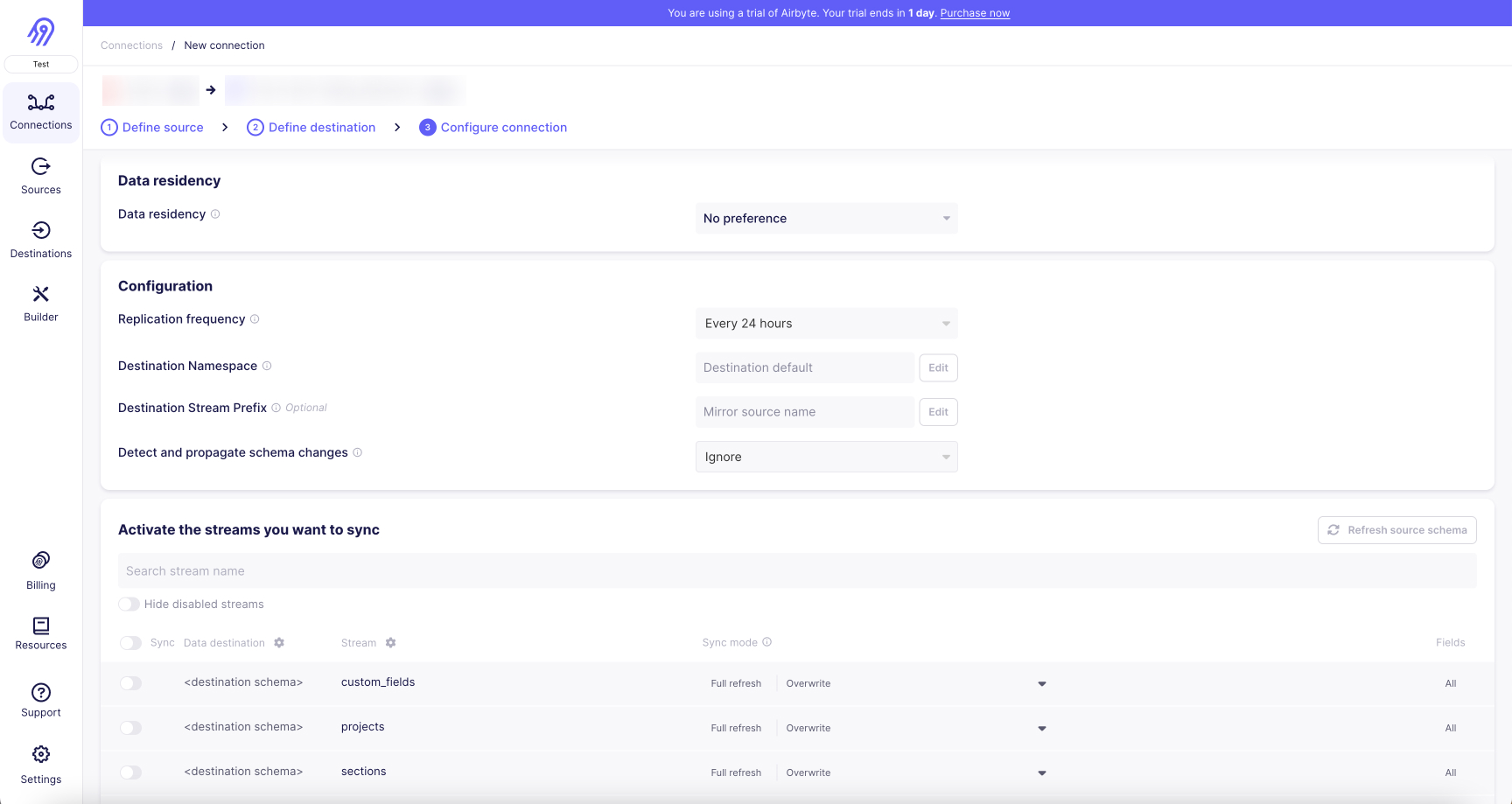
With Airbyte, creating data pipelines take minutes, and the data integration possibilities are endless. Airbyte supports the largest catalog of API tools, databases, and files, among other sources. Airbyte's connectors are open-source, so you can add any custom objects to the connector, or even build a new connector from scratch without any local dev environment or any data engineer within 10 minutes with the no-code connector builder.
We look forward to seeing you make use of it! We invite you to join the conversation on our community Slack Channel, or sign up for our newsletter. You should also check out other Airbyte tutorials, and Airbyte’s content hub!
What should you do next?
Hope you enjoyed the reading. Here are the 3 ways we can help you in your data journey:



In the evolving information technology landscape, data transfer between database systems has become crucial. This is because of specific use cases, features, and functionalities that different tools have to offer. One common example of data migration is between MySQL and PostgreSQL.
You might want to transition data from MySQL to Postgres because of Postgres’s support for advanced data types like arrays and JSON, a huge library of ready-to-use extensions, or just any other specific feature that is limited in MySQL.
This article will teach you two straightforward methods to load data from MySQL to Postgres.
MySQL Overview

MySQL is a widely known Relational Database Management System (RDMS). The syntax and features of this database are similar to Oracle and PostgreSQL, as it uses Structured Query Language (SQL) as its primary language. Like other RDMS, MySQL allows you to store and manage data in tables within rows and columns.
The structured nature of MySQL is ideal for organizations that require robust data consistency, reliability, and integrity. Some features that make it a popular database include transaction support, outstanding scalability, and strong security measures.
Key Features
- ACID Compliance: ACID stands for Atomicity, Consistency, Isolation, and Durability, a four-layer framework in MySQL that ensures the database transactions are reliable. This dependability makes it a good choice for applications that demand robust data integrity, such as financial and hospitality systems.
- Compatibility: MySQL is a platform-independent database that supports almost all operating systems, including Linux, Windows, and MacOS. In addition, it supports multiple programming languages, including Python, PHP, Java, and more, to make databases more accessible to developers. With this compatibility, you can ensure flexibility across different environments using MySQL.
PostgreSQL Overview

PostgreSQL, also known as Postgres, is one of the traditional Object-RDBMS. From its creation in 1986 at the University of California, the development community of this database has been actively working on its technology enhancements.
Postgres is an advanced enterprise-level database that supports both structured and semi-structured data. For semi-structured data, it has native support for JavaScript Object Notation (JSON) and Binary JSON (JSONB) data types, and for structured data, it conforms with SQL standards.
Key Features
- Open-source: Postgres also has an open-source environment. It has a robust development community supported by a large ecosystem of contributors and documentation. In addition, its open-source nature allows you to work in collaborative environments, which encourages developers to root for its improvement.
- Extensions: Postgres offers many built-in extensions that are pre-built templates or add-on modules used for enhanced functionality of database solutions. These extensions include: pgcrypto (gives you the ability to write cryptographic functions within the database) and PostGIS (allows you to handle spatial data).
Check out our article on PostgreSQL vs MySQL to quench your thirst for learning and gain deeper insights into database management.
Methods to Migrate Data From MySQL to PostgreSQL
- Method 1: Connecting MySQL to PostgreSQL using Airbyte.
- Method 2: Migrating data from MySQL to PostgreSQL manually.
Method 1: Connecting MySQL to PostgreSQL Using Airbyte
Airbyte is like a data engineer's secret weapon! With its powerful capabilities, you can set up various Data Integrations including MySQL to BigQuery and MySQL to Redshift, among many other connections. It's the perfect tool to supercharge your data engineering projects and make them shine!
With over 350+ pre-built connectors and a customizable pipeline configuration, it streamlines the complex tasks required to build specific data pipelines for migrating data from MySQL to Postgres. Here’s a detailed guide on migrating data between both tools:
Step 1: Configure MySQL As a Source
- Create an Airbyte account or log in to an existing one.
- On the home page, click the Sources option from the left navigation.

- Look for the search field in the Sources page and type MySQL. Click on the MySQL connector card that appears.
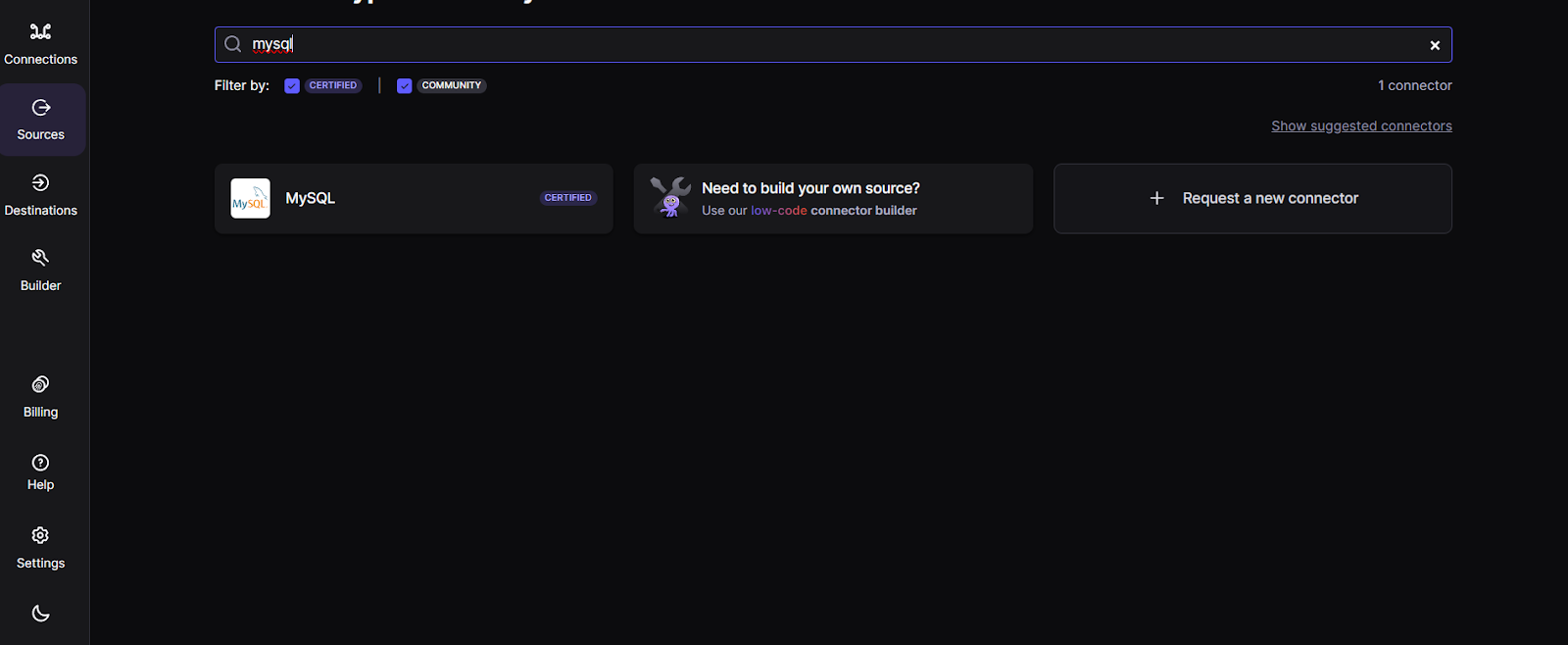
- You’ll be directed to the Create a source page of MySQL. There, fill in details in text fields including Host, Port, Database, Username, Password, and SSL modes.
- Then, in the Update Method section. Select between: Read Changes using Binary Log (CDC) and Scan Changes with User-Defined Cursor. The first method is recommended method by Airbyte that Incrementally reads new inserts, updates, and deletes using the MySQL binary log. The other method incrementally detects new inserts and updates using the cursor column chosen when configuring a connection.
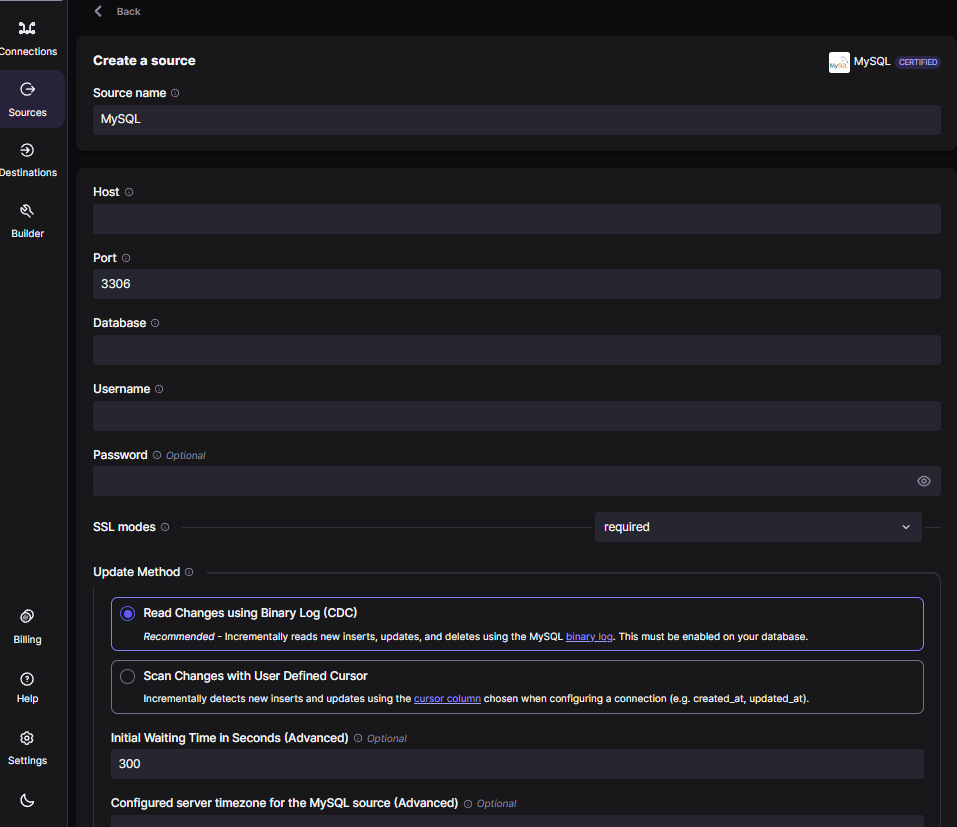
- Configure other optional fields as per your requirement and click Set up source.
Step 2: Configure Postgres As a Destination
- After configuring MySQL, click on the Destinations section from the left navigation bar.
- On the Destinations page, type in Postgres in the search bar.
- Click on the Postgres connector card.

- You’ll be directed to Create a destination page. Fill in the details such as Host, Port, DB Name, Default Schema, User, SSL modes, and SSH Tunnel Method.
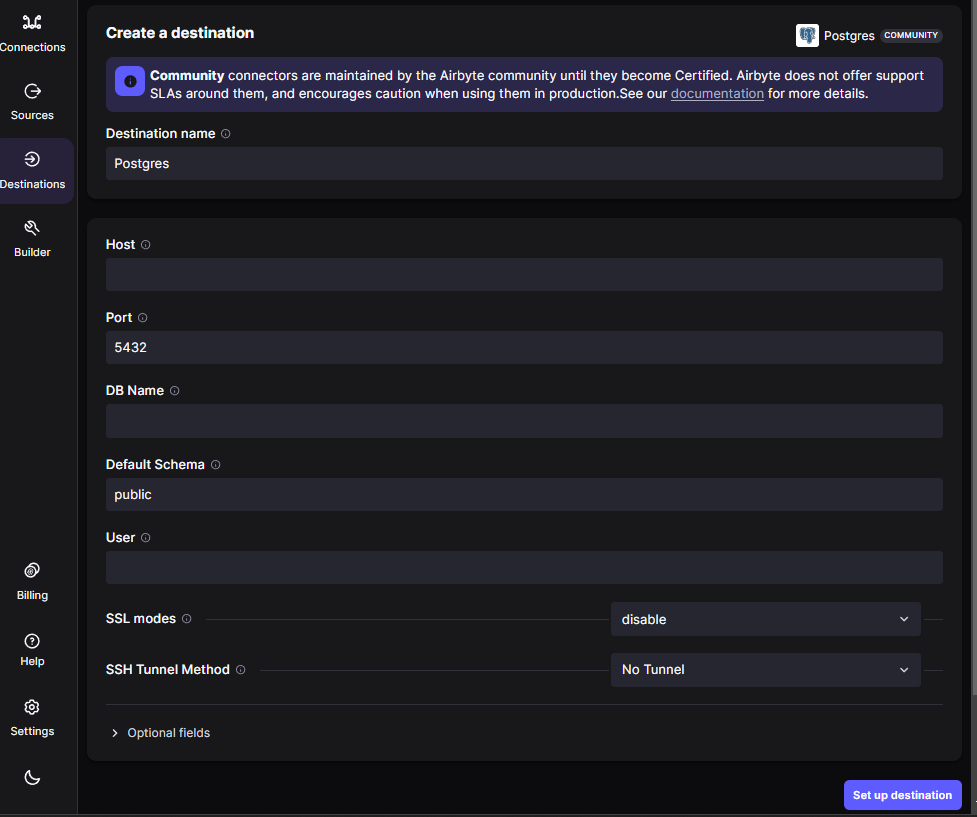
- Optionally, configure optional fields and click Set up destination.
Step 3: Create A Connection Between MySQL And Postgres
- Now that you have configured the source and destination click on Connections from the left navigation bar.

- On the Connections page, click Create a connection button and select MySQL as a source and Postgres as a destination to establish a connection.
- Provide a unique Connection name for the connection and select Replication frequency. You can choose to tweak the Streams section and select sync mode.
- Click on Set up connection > Sync now to run synchronization.
You have successfully installed a connection between MySQL and PostgreSQL using Airbyte.
Benefits of Using Airbyte
Airbyte offers a powerful solution for migrating data from MySQL to PostgreSQL seamlessly, ensuring a smooth transition with minimal manual intervention.
- Automated Data Synchronization: Airbyte automates data synchronization between MySQL and PostgreSQL, reducing manual intervention and ensuring timely updates.
- Support for Incremental Updates: With Airbyte, users can transfer only modified or new data, optimizing resource utilization and reducing processing time.
- Robust Error Handling: Equipped with robust error handling mechanisms, Airbyte promptly detects and resolves data transfer errors, ensuring the integrity and reliability of the migration process.
- Reduced Risk of Errors: By automating data transfer tasks and providing built-in validation features, Airbyte minimizes the risk of human errors, ensuring the accuracy and completeness of migrated data.
- Scalability: Airbyte is designed to handle large volumes of data efficiently, ensuring optimal performance and reliability as organizations scale their migration efforts.
Method 2: Migrating Data From MySQL to PostgreSQL Manually
In this method, you will parse SQL files from MySQL to PostgreSQL and manually move data from one database to another. Here is a detailed guide on how to export MySQL data to Postgres:
Prerequisites
- MySQL Server.
- PostgreSQL Server.
- Windows PowerShell or git bash.
Step 1: Create PostgreSQL Schema
Before moving forward with the migration process, a clear understanding of the changes required to work with Postgres is needed. In this step, you must create a new schema in the PostgreSQL database and match the structure of the MySQL database, Since each database uses its own data types, storage formats, and SQL syntax, this step is very crucial. You can choose to do schema conversion manually by tweaking data types, as both databases have partially similar structures. However, you can also use libraries such as DBConvert to do this task for you.
Step 2: Export Data From MySQL
Open the terminal and navigate to the directory where MySQL is installed. Type in the following command:
Replace username with MySQL username.
Now, use the mysqldump command to export the MySQL database into a file. Type this command to perform this task:
Replace username with MySQL username, your_database with the name of MySQL database, and mysql_data.sql with the file name in which you want to store exported data.
Note: You can also choose to export specific tables and objects from the MySQL database using the mysqldump command.
After you get the file, type in mysql exit and close the terminal.
Step 3: Import Data into PostgreSQL
Open the terminal and go to the Postgres directory. Run the following code to access the database:
From the above code, replace username with your Postgres username and your_database with the database name you want to access.
Now you are connected, you must import the data of the MySQL database to Postgres. Run the following code to achieve this task:
The above command will connect to a specific database (your_database) as a specified user (username) and execute the SQL commands contained in the mysql_data file while importing the data.
Note: The schema in your Postgres database should be compatible with data in mysql_data.sql file. Therefore, make sure Step 1 is carried out carefully.
That concludes it. If you have followed every step of the manual method, you can migrate data from MySQL to Postgres without difficulty.
Limitations of Using a Manual Method
- Time Consumption and Expertise: Manually connecting MySQL to Postgres can be complicated and time-consuming, particularly for huge databases. It requires a deep level of expertise and a thorough understanding of both database's work in terms of data types, SQL syntax, and storage formats.
- Error-prone: The manual method requires converting schema and custom coding for moving data from MySQL to Postgres. Tweaking data types, SQL syntax, and writing codes increases the risk of human error, which can lead to data loss and integrity issues.
- Lacks Automation: Compared to specialized migration tools like Airbyte, the manual method lacks automation capabilities. This can be human resource intensive as you have to execute and monitor each step carefully.
Why switch from MySQL to PostgreSQL?
Migrating from MySQL to PostgreSQL is often driven by the need for advanced features, improved scalability, and enhanced data integrity within an organization. Let's explore a typical scenario:
Use Case: E-commerce Platform Upgrade
An established e-commerce platform has relied on MySQL as its primary database system for several years. However, as the platform expands and data complexity grows, it becomes apparent that MySQL's capabilities may not suffice to meet evolving demands. To address this, the organization opts to migrate its database to PostgreSQL, drawn by its advanced functionalities and scalability.
Key Considerations:
- Advanced Features: The e-commerce platform aims to introduce innovative features like support for arrays and JSON data types to better organize and manage product information. PostgreSQL's robust support for such advanced data types aligns perfectly with their objectives.
- Data Integrity: With a surge in transaction volumes and customer data, maintaining data integrity becomes paramount. PostgreSQL's robust support for foreign key constraints, transactions, and ACID compliance ensures the necessary level of data consistency critical for business operations.
- Scalability: Anticipating significant growth in traffic and data volume, the e-commerce platform requires a database system capable of handling increased workloads effectively. PostgreSQL's scalability features, including table partitioning and parallel query processing, provide the necessary scalability to accommodate future growth.
- Compatibility: While MySQL has served their immediate needs, the organization recognizes the advantages of PostgreSQL's stricter adherence to SQL standards. This ensures better compatibility with third-party tools and applications, reducing the risk of compatibility issues in the future.
Migration Approach:
- The organization adopts a phased migration strategy, beginning with a comprehensive assessment of their existing MySQL database schema and data. They leverage migration tools and scripts to automate the schema conversion process and conduct data migration incrementally to minimize downtime and data loss.
Validation and Optimization:
- Before fully transitioning to PostgreSQL, extensive testing and validation are conducted to ensure that the migrated data behaves as expected and that all application functionalities remain intact. Stakeholders from various teams are involved to validate the migration process and promptly address any issues that arise.
- Following migration completion, the organization focuses on optimizing the PostgreSQL database configuration and performance tuning to maximize efficiency and resource utilization.
In conclusion, migrating from MySQL to PostgreSQL empowers the e-commerce platform to upgrade its database infrastructure, aligning with current and future business needs. This facilitates continued growth and innovation in their online business operations, ensuring they remain competitive in the dynamic e-commerce landscape.
Conclusion
You now know two easy methods for synchronizing data between MySQL and Postgres. The first method uses Airbyte to automate the connection between both tools. You have to configure MySQL as a source and Postgres as a destination and create a connection between them. Just like that, the migration will be successful within a few clicks.
The other method involves a manual intervention to complete the same task. You have to create and verify the schema structure as well as export MySQL data into a .sql file before uploading it to the Postgres table. This process is time-consuming and has a lot of limitations mentioned above.
Integrating data from MySQL to Postgres brings a whole bunch of benefits to the table. And when you utilise one of the powerful data migration tools like Airbyte to the mix, it's like adding a whole new set of feathers to its cap! Airbyte's rich functionalities, like 350+ pre-built connectors, robust orchestration capabilities, and an easy-to-use interface, make data integration easier.
FAQs (Frequently Asked Questions)
- What are the main reasons for migrating data from MySQL to PostgreSQL?
Organizations may migrate data from MySQL to PostgreSQL for various reasons. These include PostgreSQL's support for advanced data types like arrays and JSON, compliance with SQL standards, and robust features such as ACID compliance and advanced indexing options. Additionally, PostgreSQL's ability to handle both structured and semi-structured data, along with its vast library of extensions, make it an attractive choice for organizations with complex application needs. Overall, PostgreSQL offers enhanced flexibility and capabilities, prompting organizations to migrate from MySQL for improved database management. - What are the main considerations when deciding between manual migration and using ETL tools like Airbyte?
When deciding between manual migration and using ETL tools like Airbyte, users should consider factors such as the size and complexity of the dataset, the level of automation required, and available resources and expertise. While manual migration offers more control, it is time-consuming and error-prone. In contrast, ETL tools provide automation, scalability, and built-in data validation features, making them suitable for large-scale migrations and complex data transformation tasks. - What tools are available for migrating from MySQL to PostgreSQL?
Popular migration tools include AWS Database Migration Service, pgLoader, open-source ETL tool, and EDB Migration Toolkit. These tools facilitate schema conversion, data migration, and replication setup, simplifying the migration process. Evaluate their features, compatibility, and ease of use to choose the best fit for your migration needs. - How does Airbyte ensure data integrity and consistency during the migration process?
Airbyte employs various mechanisms to ensure data integrity and consistency during the migration process. It validates data at each step, detects and handles errors promptly, and provides logging and monitoring capabilities for transparency and accountability. Additionally, a robust Data Integration tools, like Airbyte.
What should you do next?
Hope you enjoyed the reading. Here are the 3 ways we can help you in your data journey:



Should you build or buy your data pipelines?
Download our free guide and discover the best approach for your needs, whether it's building your ELT solution in-house or opting for Airbyte Open Source or Airbyte Cloud.

Ready to get started?
Frequently Asked Questions
MySQL provides access to a wide range of data types, including:
1. Numeric data types: These include integers, decimals, and floating-point numbers.
2. String data types: These include character strings, binary strings, and text strings.
3. Date and time data types: These include date, time, datetime, and timestamp.
4. Boolean data types: These include true/false or yes/no values.
5. Spatial data types: These include points, lines, polygons, and other geometric shapes.
6. Large object data types: These include binary large objects (BLOBs) and character large objects (CLOBs).
7. Collection data types: These include arrays, sets, and maps.
8. User-defined data types: These are custom data types created by the user.
Overall, MySQL's API provides access to a wide range of data types, making it a versatile tool for managing and manipulating data in a variety of applications.